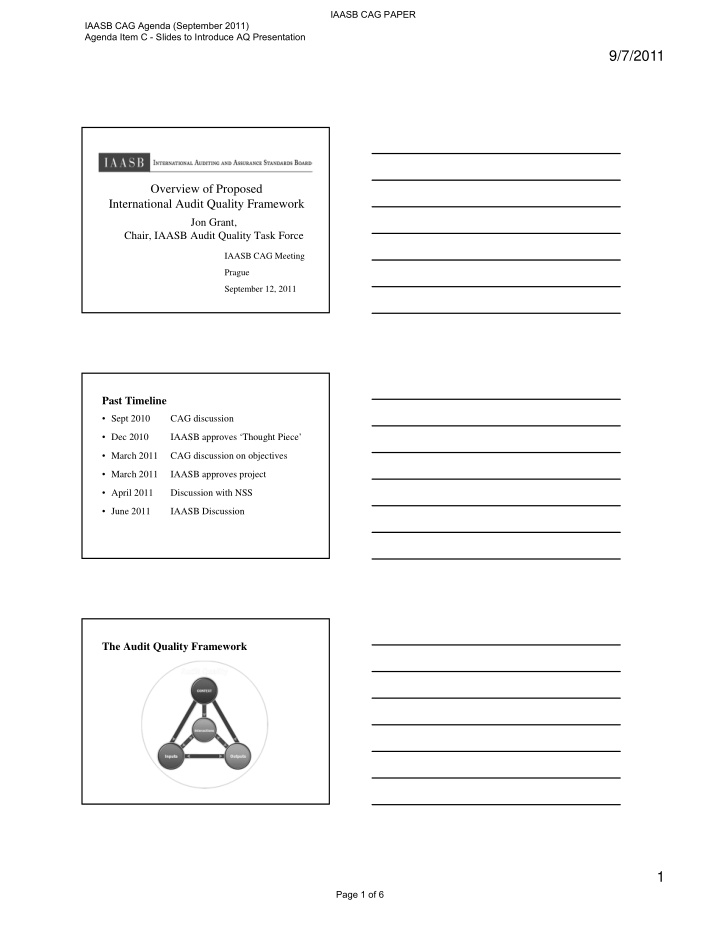



IAASB CAG PAPER IAASB CAG Agenda (September 2011) Agenda Item C - Slides to Introduce AQ Presentation 9/7/2011 Overview of Proposed International Audit Quality Framework Jon Grant, Chair, IAASB Audit Quality Task Force IAASB CAG Meeting Prague September 12, 2011 Past Timeline • Sept 2010 CAG discussion • Dec 2010 IAASB approves ‘Thought Piece’ • March 2011 CAG discussion on objectives • March 2011 IAASB approves project • April 2011 Discussion with NSS • June 2011 IAASB Discussion The Audit Quality Framework 1 Page 1 of 6
IAASB CAG PAPER IAASB CAG Agenda (September 2011) Agenda Item C - Slides to Introduce AQ Presentation 9/7/2011 Key Interactions Influencing Audit Quality • Auditors and management • Auditors and those charged with governance • Management and those charged with governance • Auditors and regulators • Management and regulators • Regulators and those charged with governance • Auditors and financial statement users • Those charged with governance and financial statement users • Audit regulators and financial statement users Context Factors • Business practices • Corporate governance requirements • The applicable financial reporting framework • Audit regulation • Industry, information technology and the general economic environment • The educational environment for accountants and auditors and respect for the role of audit • Broader cultural issues Input Factors • The culture within an audit firm, e.g. – Appropriate governance arrangements are in place. – Financial considerations do not drive actions and decisions that have a negative effect on audit quality. – Partners are accessible both to their own staff and to management and those charged with governance of the entities they audit. – The firm promotes the merits of consultation on difficult issues. – Audit quality is monitored and appropriate consequential action is taken. 2 Page 2 of 6
IAASB CAG PAPER IAASB CAG Agenda (September 2011) Agenda Item C - Slides to Introduce AQ Presentation 9/7/2011 Input Factors • The knowledge, experience, and personal attributes and values of audit partners and staff, e.g. – Partners and staff understand their clients’ business. – Partners and more senior staff provide less experienced staff with timely appraisals and appropriate coaching or “on-the- job” training. – Partners and staff have integrity, act objectively and comply with relevant ethical requirements. – Partners and staff demonstrate skepticism and professional competence. Input Factors • The effectiveness of the audit process, e.g. – The engagement team makes proper use of technology. – The audit methodology does not discourage individual team members from thinking creatively, applying skepticism, and exercising judgment. – There is effective engagement with the auditors of other components in the group (where applicable). – The audit process is adapted to developments in professional standards and is responsive to regulatory inspection findings. Output Factors • The reliability of audit reporting to users of audited financial statements • The usefulness of audit reporting to such users • The quality and usefulness of audit communications to those charged with governance • The quality and usefulness of audit communications to management • Transparency reports 3 Page 3 of 6
IAASB CAG PAPER IAASB CAG Agenda (September 2011) Agenda Item C - Slides to Introduce AQ Presentation 9/7/2011 Management Perspective of Audit Quality Engagement efficiency Professional Firm reputation Relationship Management Engagement team Perspective Partner competence and Accessibility continuity Knowledge and Communications: experience of entity quality, usefulness, and industry timeliness Audit Committee Perspective of Audit Quality Robustness of the audit Professional Firm reputation Relationship Knowledge and Partner experience of Audit Accessibility Committee entity and industry Perspective Communications: Senior team quality, usefulness, competence timeliness Independence from Efficient use of management management’s time and resources Institutional Investor and Public Sector Stakeholder Perspective of Audit Quality Strength of regulatory framework, including quality of audit committee Firm reputation Regulatory and industry inspection reports Investor / expertise Public Sector Stakeholder Perspective Quality of clients’ Perception of financial reports independence Transparency reports 4 Page 4 of 6
IAASB CAG PAPER IAASB CAG Agenda (September 2011) Agenda Item C - Slides to Introduce AQ Presentation 9/7/2011 Other Considerations • Considerations specific to small audits and SMPs, and public sector audit institutions – Interactions – Contextual factors – Input factors – Output factors Timetable Activity Timing Discussion with academics Aug 2011 IAASB update Sept 2011 Discussion with IFIAR Sept 2011 Discussion with Forum of Firms, ICGN, World Bank, Oct 2011 INTOSAI Discussion within IFAC: IAESB, IESBA, and SMP Oct 2011 Committee Discussion with IOSCO Nov 2011 IAASB discussion Dec 2011 IAASB approval of consultation paper Mar / June 2012 Matters for CAG Consideration • Does the proposed Framework embody the most important elements of audit quality, and is it balanced and credible? • Are there key issues or dimensions that need to be added or emphasized more? • Does the paper strike an appropriate balance between concepts and ‘real world’ audit quality? • How should IAASB best reach out to non-audit groups other than those mentioned in the timetable? • Is there value in identifying the main threats to audit quality with respect to the Framework elements, and possible actions to address such threats, as summarized in the attachment? 5 Page 5 of 6
IAASB CAG PAPER IAASB CAG Agenda (September 2011) Agenda Item C - Slides to Introduce AQ Presentation 9/7/2011 http://www.iaasb.org 6 Page 6 of 6
Recommend
More recommend